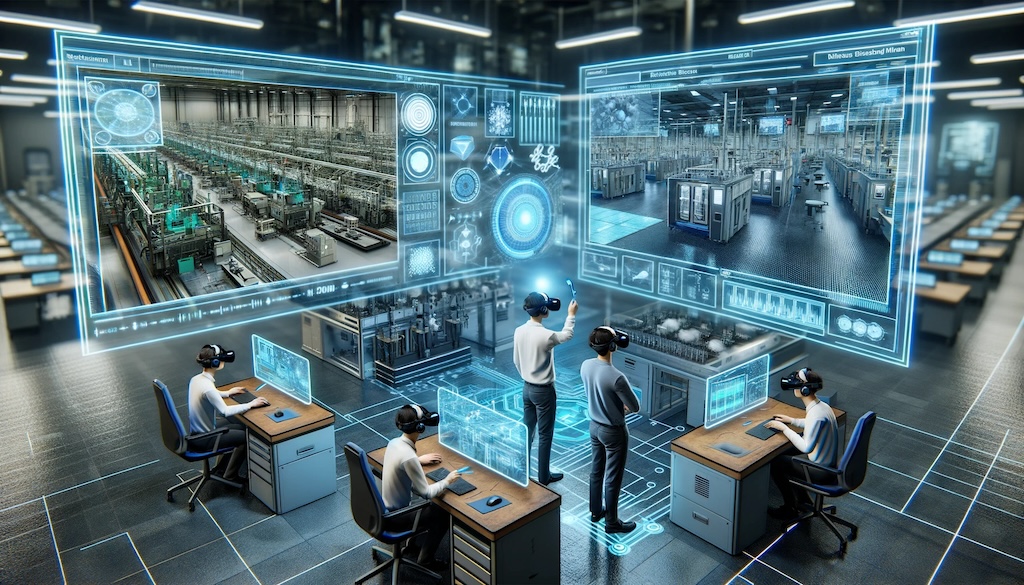Image Generated Using DALL-E
Semiconductor And Virtualization
In the ever-evolving landscape of semiconductor manufacturing, staying ahead of technological advancements and maintaining a highly skilled workforce is critical for success. While effective, traditional training methods often have significant costs, safety concerns, and accessibility limitations. Enter virtualization – a transformative approach that has revolutionized how the industry and academia train and educate individuals in the semiconductor industry.
Virtualization leverages advanced technologies to create immersive, interactive, and highly realistic simulations of semiconductor manufacturing processes. Doing so offers many benefits that traditional methods cannot match.
Application Of Virtualization In Semiconductor
By leveraging advanced technology to create immersive and interactive environments, virtualization offers unparalleled learning and skill development opportunities. This innovative approach addresses many challenges associated with traditional training methods, providing a safer, more cost-effective, and flexible alternative.
As the semiconductor industry advances rapidly, the need for up-to-date and comprehensive training programs becomes increasingly critical. Virtualization, with its inherent adaptability, meets this demand by enabling efficient, scalable, and highly effective training solutions.
Below are some key applications of virtualization in semiconductor training, highlighting how it enhances the learning experience and prepares trainees for real-world scenarios:
| Application | Details |
|---|---|
| Process Simulation | Trainees can experience and optimize various manufacturing processes in a risk-free virtual environment. |
| Equipment Operation Training | Virtual models of complex machinery help trainees learn how to operate and troubleshoot equipment effectively. |
| Cleanroom Protocols | Simulating cleanroom conditions allows trainees to practice maintaining contamination-free environments. |
| Data Analysis And Visualization | Virtual tools teach trainees how to interpret and act on process data. |
| Quality Control | Virtual environments replicate quality control scenarios, enabling trainees to identify defects and implement quality assurance measures. |
| Design And Fabrication Techniques | Virtual platforms provide detailed simulations of design and fabrication techniques, enabling learners to understand and implement advanced methods. |
| Supply Chain Management | Virtual training includes modules on managing supply chains, understanding logistics, and optimizing the flow of materials in semiconductor manufacturing. |
| Educational Courses And Certifications | Virtual platforms offer comprehensive courses and certification programs, ensuring learners are up-to-date with the latest industry standards. |
| Collaborative Projects | Students and professionals can work together on virtual projects, simulating real-world collaboration and problem-solving scenarios. |
| Virtual Reality Classrooms | Immersive virtual reality classrooms enhance the learning experience by providing interactive and engaging educational content. |
| Remote Laboratory Access | Virtualization allows for remote access to laboratory experiments and equipment, enabling students to conduct experiments and gather data remotely. |
| Interactive Tutorials And Workshops | Virtual environments host interactive tutorials and workshops, allowing learners to gain practical skills through hands-on activities. |
| Performance Tracking and Assessment | Virtual platforms track learner performance, provide detailed analytics, and offer personalized feedback to help improve skills and knowledge. |
As illustrated, virtualization’s applications in semiconductor training are diverse and impactful. From simulating complex manufacturing processes to facilitating remote learning and collaboration, virtualization empowers learners to acquire and refine critical skills in a controlled, realistic environment.
This approach enhances the quality of education and ensures that the semiconductor workforce is well-prepared to meet the demands of a rapidly evolving industry. By embracing virtualization, semiconductor manufacturers can cultivate a highly-skilled, knowledgeable, and adaptable workforce ready to drive innovation and excellence.

Cost-Effectiveness And Scalability
One of virtualization’s most compelling advantages is its cost-effectiveness. Establishing and maintaining physical training facilities with state-of-the-art equipment is a significant financial burden. Virtual labs, on the other hand, require minimal physical resources, reducing overhead costs substantially. Furthermore, these virtual environments are highly scalable, allowing for the simultaneous training of numerous individuals without additional infrastructure.
Virtual environments are not just interactive, they are designed to provide trainees with a hands-on experience that is as close to real-world as possible. These environments can simulate everything from lithography and etching to cleanroom protocols and equipment operation. The immediate feedback provided in these virtual settings is a testament to the efficiency of the learning process, helping trainees understand and correct their mistakes promptly.
Advantages Of Virtualization In Semiconductor
The semiconductor industry is highly dynamic, with continuous technological advancements necessitating equally progressive training methods. Virtualization is a pivotal tool, offering significant advantages over traditional training approaches.
Virtualization, with its realistic, interactive, and risk-free virtual environments, offers comprehensive and efficient training for semiconductor professionals. This modern approach addresses several critical challenges, ensuring trainees receive the highest quality education. Importantly, virtualization also minimizes costs and risks, providing a secure financial aspect to professionals’ training.
Below are some of the key advantages of using virtualization in semiconductor training:
| Advantage | Details |
|---|---|
| Cost-Effectiveness | Resource Optimization: Virtual labs reduce the need for physical resources and equipment, which are often expensive and difficult to maintain. Scalability: Multiple students can access virtual environments simultaneously, allowing large-scale training programs without additional physical infrastructure. |
| Safety And Risk Reduction | Enhanced Safety: Virtual environments provide a secure learning space by eliminating the risks associated with handling hazardous materials or operating complex machinery. This safety feature instills confidence in trainees, allowing them to learn and experiment without fear. Error Tolerance: Mistakes made in virtual environments do not have real-world consequences, allowing trainees to learn from their errors without risk. |
| Accessibility and Flexibility | Remote Learning: Virtualization enables remote training, allowing students and professionals worldwide to access the same high-quality educational resources. Flexible Schedules: Learners can access training modules conveniently, accommodating different time zones and personal schedules. |
| Enhanced Learning Experience | Interactive Simulations: Virtual labs can include interactive simulations that enhance understanding by providing hands-on experience with semiconductor manufacturing processes. Real-Time Feedback: Instant feedback in virtual environments helps learners understand their mistakes and correct them promptly. |
| Up-To-Date Training | Rapid Updates: Virtual training programs can be quickly updated to reflect the latest advancements and technologies in semiconductor manufacturing. Customized Content: Training modules can be tailored to specific needs, ensuring learners have relevant and current knowledge. |
| Collaboration And Skill Development | Collaborative Platforms: Virtual environments can facilitate collaboration among students, researchers, and professionals, promoting the exchange of ideas and best practices. Skill Development: Virtual training emphasizes critical thinking, problem-solving, and technical skills essential for semiconductor manufacturing. |
As demonstrated, virtualization’s advantages in semiconductor training are extensive and transformative. By leveraging virtualization, the semiconductor industry can overcome many of the limitations associated with traditional training methods.
This innovative approach enhances the learning experience and ensures that trainees are well-prepared for the challenges and opportunities of a rapidly evolving field.
In the long term, embracing virtualization is essential for cultivating a skilled, knowledgeable, and adaptable workforce capable of driving the semiconductor industry forward.





